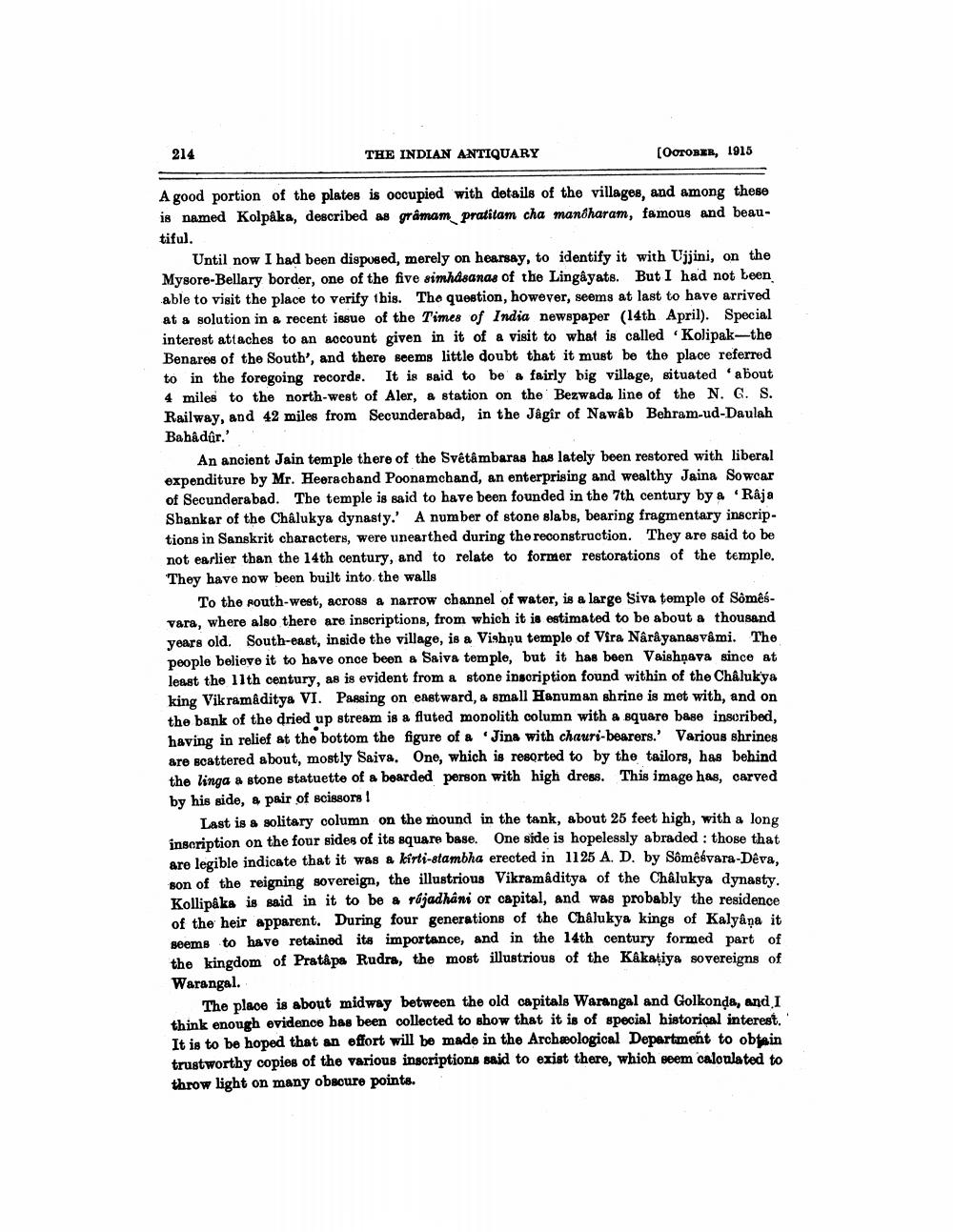________________
214
THE INDIAN ANTIQUARY
(OOTORER, 1915
A good portion of the plates is oocupied with details of the villages, and among these is named Kolpaka, described as gramam pratitam cha manoharam, famous and beautiful.
Until now I had been dispused, merely on hearsay, to identify it with Ujjini, on the Mysore-Bellary border, one of the five simhasanas of the Lingayats. But I had not been able to visit the place to verify this. The question, however, seems at last to have arrived at a solution in a recent issue of the Times of India newspaper (14th April). Special interest attaches to an account given in it of a visit to what is called Kolipak-the Benares of the South', and there seems little doubt that it must be the place referred to in the foregoing recorde. It is said to be a fairly big village, situated about 4 miles to the north-west of Aler, a station on the Bezwada line of the N. C. S. Railway, and 42 miles from Secunderabad, in the Jagir of Nawab Behram-ud-Daulah Babâdûr.'
An ancient Jain temple there of the Svêtâmbaras has lately been restored with liberal expenditure by Mr. Heeracband Poonamchand, an enterprising and wealthy Jaina Sowcar of Secunderabad. The temple is said to have been founded in the 7th century by a Raja Shankar of the Chalukya dynasty. A number of stone slabs, bearing fragmentary inscriptions in Sanskrit characters, were unearthed during the reconstruction. They are said to be not earlier than the 14th century, and to relate to former restorations of the temple. They have now been built into the walls
To the mouth-west, across a narrow channel of water, is a large Siva temple of Sômésvara, where also there are inscriptions, from which it is estimated to be about a thousand years old. South-east, inside the village, is a Vishņu temple of Vira Narayanasyâmi. The people believe it to have once been a Saiva temple, but it has been Vaishnava since at least the 11th century, as is evident from a stone inscription found within of the Châlukya king Vikramaditya VI. Passing on eastward, a small Hanuman shrine is met with, and on the bank of the dried up stream is a fluted monolith column with a square base insoribed, having in relief at the bottom the figure of a Jina with chauri-bearers. Various shrines are scattered about, mostly Saiva. One, which is resorted to by the tailors, has behind the linga & stone statuette of a boarded person with high dress. This image has, carved by his side, & pair of scissors !
Last is a solitary column on the mound in the tank, about 25 feet high, with a long inscription on the four sides of its square base. One side is hopelessly abraded : those that are legible indicate that it was a kirti-stambha erected in 1125 A. D. by Sômêsvara-Deva. son of the reigning sovereign, the illustrious Vikramaditya of the Chalukya dynasty. Kollipaka is said in it to be & rajadhani or capital, and was probably the residence of the heir apparent. During four generations of the Chalukya kings of Kalyana it seems to have retained its importance, and in the 14th century formed part of the kingdom of Pratâpa Rudra, the most illustrious of the Kakatiya sovereigns of Warangal.
The place is about midway between the old capitals Warangal and Golkonda, and I think enough evidence bas been collected to show that it is of special historical interest.' It is to be hoped that an effort will be made in the Archeological Department to obtain trustworthy copies of the various inscriptions said to exist there, which seem calonlated to throw light on many obscure points.




